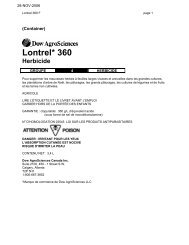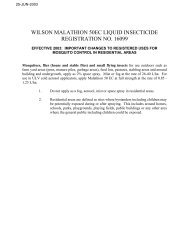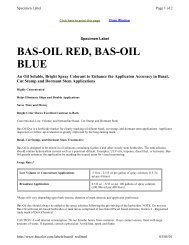FACTS ON Transline* Herbicide - TrueNorth Specialty Products
FACTS ON Transline* Herbicide - TrueNorth Specialty Products
FACTS ON Transline* Herbicide - TrueNorth Specialty Products
You also want an ePaper? Increase the reach of your titles
YUMPU automatically turns print PDFs into web optimized ePapers that Google loves.
<strong>FACTS</strong> <strong>ON</strong><br />
<strong>Transline*</strong> <strong>Herbicide</strong><br />
Weeds controlled Transline rate<br />
Canada thistle<br />
(Suppression of top growth for 6 – 8 weeks)<br />
Vetch 0.42 L/ha<br />
Alsike clover<br />
Canada thistle (Season-long control)<br />
Scentless chamomile<br />
Perennial sow thistle (top growth)<br />
Ox-eye daisy (suppression) 0.56 L/ha<br />
Common groundsel<br />
Common ragweed<br />
Wild buckwheat<br />
Sheep sorrel (suppression)<br />
Spotted knapweed<br />
Diffuse knapweed<br />
Canada thistle<br />
(Season-long control plus stand reduction<br />
in the following year)<br />
Application<br />
0.70 L/ha<br />
0.83 L/ha<br />
Additional weeds which Transline shows a high degree of activity include:<br />
coltsfoot, dandelion, volunteer alfalfa and sweet clover.<br />
Apply Transline to emerged weeds using broadcast spray<br />
applications, backpack sprayers or high volume hose and<br />
hand gun treatments.Transline is not labeled for application<br />
by air. Refer to product label for detailed directions that will<br />
help ensure crews apply the herbicide correctly.<br />
TIMING<br />
Apply Transline to weeds that are fully emerged and actively<br />
growing. Canada thistle, for example, is best sprayed in the<br />
rosette to pre-bud stage.<br />
RAINFASTNESS<br />
Transline is rainfast 4 to 6 hours after application.<br />
Transline herbicide provides outstanding<br />
control of the toughest broadleaf weeds<br />
without harming desirable vegetation. Its<br />
highly selective, systemic mode of action<br />
makes it an ideal vegetation management tool in utility<br />
rights-of-way, railways, roadsides, industrial sites and other<br />
non-cropland areas. With the active ingredient clopyralid,<br />
Transline is a low residual, low environmental impact<br />
herbicide that controls noxious weeds while preserving<br />
desirable plant species.<br />
How Transline works<br />
Transline enters treated vegetation through the leaves and<br />
roots, and uses the plants own nutrient and water<br />
transportation system to move throughout the plant. It works<br />
like a natural growth regulator found only in plants, causing<br />
disruption of plant growth processes. Sufficient amounts then<br />
accumulate in the growing points of the plant and result in<br />
plant death.<br />
HOW IT BREAKS DOWN IN THE ENVIR<strong>ON</strong>MENT<br />
Clopyralid binds to organic matter in soils and is nonvolatile.<br />
It will not leave the soil or vegetation and enter<br />
the air as a gas.<br />
In the soil, clopyralid has a half-life of 8 to 66 days.<br />
Degradation is faster in warm, moist conditions and slower<br />
in cold, dry conditions.<br />
Field studies demonstrate fairly rapid degradation and<br />
limited downward movement (45cm).<br />
Clopyralid does not pose a threat to groundwater.<br />
Residues of the herbicide occurring in grass may be<br />
harmful to susceptible plants. Do not use vegetation<br />
from treated areas for composting or mulching around<br />
susceptible broadleaf crops, gardens or nurseries.<br />
WILDLIFE AND LIVESTOCK<br />
When used according to the label,Transline poses no threat<br />
to wildlife. In fact, eliminating selected weeds with Transline<br />
can promote wildlife diversity because weed removal lets<br />
grasses and other desirable vegetation re-establish in the<br />
treated areas.This produces an environment where many<br />
wildlife species can thrive.<br />
There are no grazing restrictions for livestock, so treated<br />
areas can be grazed or harvested for animal feed any time<br />
after application.
Safe to wildlife<br />
Transline is low in toxicity to mammals, birds, fish and bees.<br />
MAMMALS<br />
Mammals do not metabolize clopyralid. If ingested, it is rapidly<br />
excreted unchanged.Animal studies have shown that clopyralid<br />
consumed in the diet will be cleared from the body within 5<br />
days of intake, with no accumulation in the body organs.<br />
Oral LD50: > 5,000 mg per kg of body weight (rat).This<br />
falls under “non-hazardous” in oral LD50 guidelines.<br />
There is no evidence that clopyralid causes carcinogenic,<br />
mutagenic or teratogenic effects, or interferes with<br />
reproduction in mammals. Although small amounts<br />
swallowed incidental to handling are unlikely to cause<br />
injury, avoid contact with the mouth.<br />
AQUATIC ORGANISMS<br />
Clopyralid has a very low toxicity for aquatic organisms,<br />
and under proper operational use conditions, clopyralid or<br />
Transline poses no threat.<br />
Organism Compound 96-hour LC50<br />
(mg/L)<br />
Rainbow trout Clopyralid 103.5<br />
Bluegill Clopyralid 125.4<br />
Based on the guidelines for 96-hour LC50 toxicity ratings for<br />
aquatic organisms, clopyralid is safer than the “slightly toxic”<br />
category. Care should be taken not to apply Transline to<br />
water surfaces.<br />
BIRDS<br />
Clopyralid has very low toxicity to birds, in terms of both<br />
single dose (oral LD50) and longer-term (8-day dietary LC50)<br />
exposure.<br />
Oral LD50 : >1,465 mg per kg body weight (mallard duck).<br />
Based on guidelines, this is regarded as “slightly toxic.”<br />
8-day dietary LC50 : >4,460 ppm (mallard duck and<br />
bobwhite quail). Based on guidelines, this is in the“least<br />
toxic” category.<br />
H<strong>ON</strong>EY BEES<br />
Clopyralid is non-toxic to honey bees, even when direct<br />
contact occurs.<br />
Contact LD50 for honey bee: >100 mg per bee<br />
What else do you need?<br />
For even more information on how Dow AgroSciences can help meet your vegetation<br />
management needs, call the Solutions Center at 1-800-667-3852 or visit us at www.dowagro.ca.<br />
* Trademark of Dow AgroSciences LLC<br />
0205-475-021<br />
Q & A about Transline<br />
WHAT ARE THE ADVANTAGES OF TRANSLINE?<br />
It is a selective herbicide, so it controls only broadleaf<br />
weeds without affecting desirable grasses.This allows<br />
grasses to flourish by removing competition from weeds.<br />
Non-selective herbicides (e.g. glyphosate) damage grasses<br />
and other plants.<br />
Transline allows you to apply in areas where the activity on<br />
trees and brush, from a soil residual herbicide is not needed.<br />
Transline will not be taken up by roots of trees or<br />
susceptible vegetation adjacent to the treatment area.<br />
Many of todays agricultural crops, such as wheat, barley,<br />
canola, flax and corn are not sensitive to off target<br />
movement of Transline.<br />
It controls down to the roots of perennials such as Canada<br />
thistle and scentless chamomile.<br />
WHAT RESULTS CAN BE SEEN AFTER APPLICATI<strong>ON</strong>?<br />
Results such as yellowing and twisting will be apparent on<br />
weeds within a week, but it may take up to six weeks to see<br />
the full effect of plant browning and shriveling. Unlike contact<br />
herbicides,Transline moves into the stem and root system to<br />
provide long-lasting control.<br />
SHOULD WE MIX SURFACTANTS WITH TRANSLINE?<br />
No.Transline already has an optimized formulation that does<br />
not require additional surfactants.<br />
CAN TRANSLINE BE TANK MIXED WITH OTHER<br />
HERBICIDES?<br />
Yes, labeled tank mixes include 2,4-D and MCPA to<br />
broaden the spectrum of broadleaf weeds controlled. Refer<br />
to the Transline label for complete details.<br />
WHY IS CANADA THISTLE SO DIFFICULT TO C<strong>ON</strong>TROL?<br />
Canada thistle has perennial growth because of its<br />
extensive root system, especially in stands that are old and<br />
well-established.The underground root system produces<br />
new shoots and stores food reserves. Mowing and using<br />
burndown herbicides are only temporary solutions, from<br />
which the Canada thistle plant quickly recovers. Recent<br />
research by Dr. Edward Bork at the University of Alberta<br />
found that mowing alone actually causes thistle infestations<br />
to increase.<br />
Transline is a low toxicity product.Always follow label instructions.<br />
Minimize exposure by wearing recommended personal protective equipment.


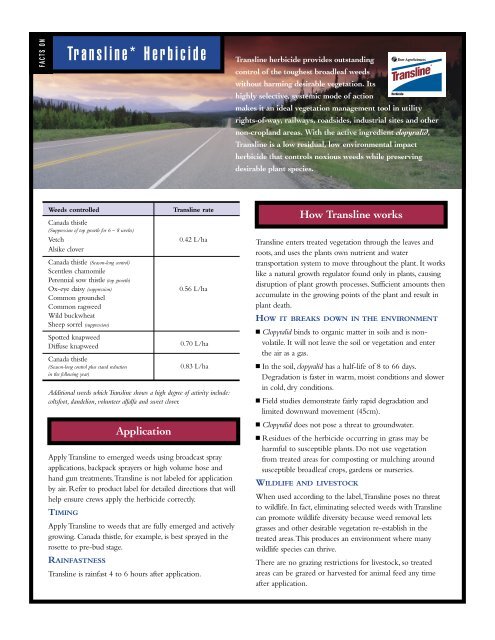

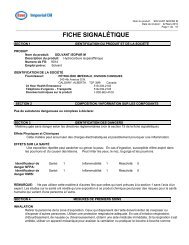
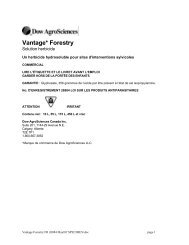
![Princep NineT [pamphlet] - True North Specialty Products](https://img.yumpu.com/17323153/1/190x245/princep-ninet-pamphlet-true-north-specialty-products.jpg?quality=85)
